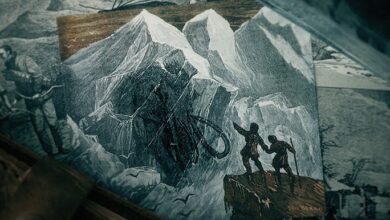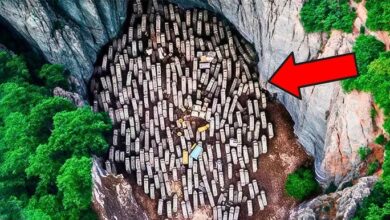US Scientists Discovered Something Strange in Antarctica

In 1964, a Russian team led by Andre Kitza from Moscow State University conducted a seismic experiment in East Antarctica, near the Vostok research station. They measured the thickness of the ice there, unaware that there was a major undiscovered discovery beneath their feet. In 1973, a new expedition from the United States, Great Britain and Denmark returned to the same area and discovered a secret so astonishing that it seemed unbelievable at first. They discovered one of the largest freshwater lakes under the ice, a lake that had been completely isolated from the outside world for millions of years. The lake was named after the Vostok station and attracted global attention, becoming the subject of major research because of its potential to change our understanding of life and its evolution on Earth, and perhaps even on other planets. Lake Vostok is about 149 km long, 31 km wide and 746 m deep, which is about the same as Lake Ontario between the US and Canada.
Lake Vostok has been completely cut off from sunlight, wind and surface life for millions of years. The water temperature of this lake fluctuates around 10°C, suggesting that the lake is heated by geothermal sources, possibly connected to other subglacial lakes and forming a unique ecosystem. The oxygen concentration in Lake Vostok water is 50 times higher than in normal fresh water, and although the pressure of the ice layer is very high (about 300 atmospheres), this does not rule out the possibility of life existing here.
Another special feature of the lake is a dome-shaped air chamber, which rises several hundred meters above the lake’s surface. After this amazing discovery, drilling began in 1989 and on February 5, 2012, scientists reached the surface of the lake at a depth of 12,365 ft. After analyzing samples from the lake, researchers suggested that Lake Vostok may contain a unique ecosystem that relies on chemicals from rocks instead of sunlight. They discovered a previously unknown species of organism that is believed to derive energy from minerals in rocks and mud below the lake.
The water samples also contained bacteria that are parasites of fish, leading to the hypothesis that there may be complex living organisms that have not yet been discovered. In addition, scientists discovered cold-tolerant organisms (psychrophiles) and heat-loving organisms (thermophiles), suggesting that there may be hydrothermal vents deep below the lake.
This discovery not only brings new information about the possibility of life under the deep ice layers on Earth, but also opens up hope for the search for life on other planets. Researchers believe that subglacial lakes like Lake Vostok may exist not only on Earth but also on planets and moons in the Solar System, such as Jupiter’s moon Europa, Saturn’s moons, and even at the poles of Mars.
In addition to subglacial lakes, another notable discovery in the Antarctic region is the Mount Erebus volcano. This is the largest active volcano in Antarctica, existing for 1.3 million years, and has a system of ice caves formed by volcanic steam. These caves have temperatures of up to 25°C, allowing life to exist even in an extremely cold land.
Recent studies have also found that under the ice of Antarctica there may be dense structures, such as a giant crater caused by a meteorite impact. This discovery has led to the hypothesis that the asteroid impact may have caused a major extinction event in Earth’s history about 250 million years ago.
In addition, Antarctica is currently facing a worrying change. One of the world’s largest ice sheets, A23A, has begun to move and melt rapidly, leading to the risk of rising global sea levels. In addition, Glacier Thwaites, also known as the “Doomsday Glacier”, is melting rapidly due to the impact of underground heat sources and warm ocean water penetrating the ice.
All of these findings suggest that Antarctica is not only a place that holds many secrets about life and the Earth’s climate, but also a place that may have huge resources, such as oil, gas, and precious minerals. These discoveries will not only advance scientific research but could also be game-changers in international politics, as nations continue to vie for control of territory and resources in Antarctica.

The theory that dinosaurs in ancient Antarctica rejected air through their nostrils to avoid danger, like igniting something, remains unproven. However, both herbivorous dinosaurs and predators like the mosasaurs, which lived in Antarctica, used their abilities primarily for protection. Mosasaurs, with their sharp teeth and powerful jaws, tore apart marine reptiles, particularly turtles and plesiosaurs. Around 56 million years ago, during the Eocene Epoch, Antarctica warmed enough for forests to replace glaciers. These forests were home to palm-like trees, conifers, and southern beaches, inhabited by early marsupials and creatures like a horse-camel hybrid and large, bird-like creatures with bone spikes for catching squid and fish. At the end of the epoch, Antarctica cooled again, becoming the ice-covered land we recognize today.
Despite its icy surface, recent discoveries beneath Antarctica’s ice reveal hidden rivers, canyons, and lakes—over 400 lakes, to be precise. One of the largest, discovered using radar, is the Snow Eagle Lake, 48 km long and 15 km wide, roughly the size of Flathead Lake in Montana. In these subglacial waters, scientists have found mysterious creatures. A Ukrainian researcher discovered a leech that grows three times its size after feeding, while German scientists identified fish with large, dark eyes, possibly adapted to the perpetual darkness beneath the ice.
Though these creatures have adapted to survive in extreme conditions, their existence is at risk. Rising temperatures could trigger the melting of the ice, causing significant global consequences. If Antarctica’s ice sheets melt completely, sea levels could rise by about 70 meters, flooding coastal cities worldwide. For example, Florida, the Gulf Coast, and parts of California would vanish, while areas like San Francisco’s hills would become islands. Coastal regions of South America, like Buenos Aires, and parts of Egypt would also be submerged. In addition to rising seas, the melting could contaminate freshwater supplies, as the ice holds 70% of the world’s fresh water, turning it undrinkable when mixed with seawater.
This global catastrophe could also lead to severe weather changes, such as more intense storms, tsunamis, and volcanic eruptions. Fertile lands could turn to deserts, and other areas would face regular flooding, making agriculture nearly impossible. The lack of food would lead to widespread conflict, and the resurgence of diseases like anthrax, which previously broke out in 2016, would pose a major health threat.
Yet, there is some hope. If Antarctica becomes more habitable as its ice melts, refugees might find space to settle, though farming and livestock would be nearly impossible due to harsh conditions. Mining for oil, gas, and minerals is a possibility, but the continent’s extreme environment would limit large-scale living.
Efforts to prevent this disaster are ongoing. One proposal is to place a reflective raft of membranes in space to deflect sunlight, reducing global temperatures by 1.5%. Although this is still an early concept, it represents a potential solution. However, experts agree that the situation is urgent, as climate change accelerates the melting of Antarctica’s ice. The Brunt Ice Shelf, for example, is cracking, with large icebergs set to break off soon. This process, while natural, is becoming more unpredictable and linked to climate change.
Antarctica’s ice shelves are particularly vulnerable to ocean warming, which erodes the ice from beneath. Since 1992, Western Antarctica has lost about 65 million metric tons of ice annually. The ice in regions like the Amundsen Sea could raise global sea levels by 4 feet. If the entire West Antarctic Ice Sheet were to melt, it could raise sea levels by up to 16 feet, permanently altering coastlines. Predictions suggest sea levels could rise by 1-3 feet by 2100, but this doesn’t account for the full extent of potential ice loss.
This ongoing instability in Antarctica’s ice sheets poses a serious threat, as the melting accelerates. If large sections of the ice break off, as they did in the Larsen C Ice Shelf in 2017, the ice sheet becomes unstable, leading to more rapid melting and further ice flow into the ocean. This cycle could contribute to catastrophic sea-level rise, reshaping the global landscape and affecting millions of people living near coastlines.








